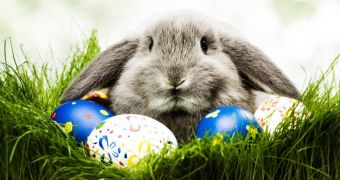Easter is upon us and people around the world are preparing to celebrate this important religious holiday through different traditions, many of which are hundreds of years old. While some nations dedicate this holiday to Christ’s resurrection, others have grown accustomed to get involved in some rather weird traditions, but which are very meaningful in their own way.
Thus, while some traditions are fairly common, others are more eccentric, up to being downright dangerous, but to the community involved in them, they are as natural and normal a way to commemorate the season as chocolate eggs and magical rabbits.
The most common symbols of Easter are, of course, the dyed eggs and the Easter rabbit. Eggs have been a symbol of spring since ancient times, but they are also a symbol of the rock tomb out of which Christ emerged when he arose again. People in many countries paint eggs in different colors and then bash one hard-boiled egg on another and the owner of the one that doesn't break wins the contest.
The rabbit, or hare, has a similar symbolism as it is believed to be a sign of an abundant new life and fertility. Over time, the Easter Bunny, like Santa Claus, has become a popular children's character.
But besides that, there are some Easter traditions around the world perceived as weird and uncommon.
Bermudians, for instance, celebrate Good Friday by flying homemade kites and eating codfish cakes and hot cross buns. The unusual tradition involving kites is said to have begun when a teacher from the British Army didn’t know how to explain Christ's ascension to Heaven to his students. However, he found an ingenious way to exemplify the Christian legend – he built a kite, traditionally shaped like a cross, to illustrate Ascension.
Since 1857, a strange parade has taken place in the town of Bacup in Lancashire on Easter Saturday. It is called the Nutter’s Dance and involves people dressed oddly, with blackface makeup on, bells on their legs and dancing in formation as part of a weird ritual that seems like a social exorcism designed to fend off evil spirits.
Meanwhile, in Slovakia and the Czech Republic, women get whipped as part of the tradition. Nonetheless, the practice is not intended to be painful and it is actually believed to have a beneficial effect on women – it allegedly makes them more beautiful and healthy. According to the legend, the whips made of willow represent the first tree to blossom during this season, so the branches also said to bring women the tree’s fertility and vitality.
Norwegians have an interesting tradition for the holiday known as “Easter-Crime.” Don’t worry, it has nothing harmful in it, it’s just an innocuous custom related to literature. At this time of the year, many people around the country read mystery books or watch crime detective series on national television.
On the other hand, in some countries in Northwestern Europe, people lit large Easter Fires on Easter Sunday and Monday. The fires are made up of scrap wood, gathered usually by over-enthusiastic young boys who scour their neighborhoods for them, in order to make their fire as great as it can be. The explanation for this is quite simple: Easter is a time when spring becomes victorious over winter and the fires are made to chase the darkness of winter away, according to the legends.
And in Haux, France, a giant omelet made of over 4,500 eggs is prepared one day after the celebration and served up in the town’s main square. By the looks of it, this tradition has begun during Napoleon’s time, when the ruler and his army stopped in a small town in the south of France and ate omelets. He supposedly liked the omelet so much that he ordered all locals to gather their eggs and make a giant omelet for his army the next day.
Finally, in Haiti, people celebrate Holy Week with colorful parades and traditional “rara” music played on bamboo trumpets, maracas, and drums. In this region, the holiday is a mixture of Catholic and Voodoo traditions, so it is marked by drumming, chanting and animal sacrifice.

 14 DAY TRIAL //
14 DAY TRIAL //